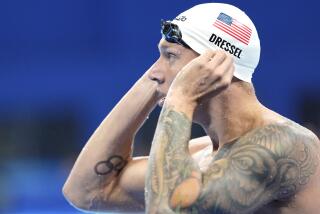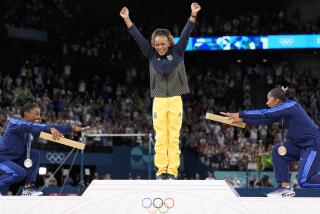Heike Drechsler’s Future Has a Golden Look
- Share via
Nobody can say with assurance that Heike Drechsler will match Carl Lewis’ four Olympic gold medals in Seoul in 1988.
Boycott, injury, a dropped baton--all must be considered threats to upset the timetable. On ability alone, however, there is no question that Drechsler has the Midas touch.
Drechsler already owns a couple of items that Lewis doesn’t--outdoor world records in the long jump and 200 meters. She is ranked first in the world in both events, and is ranked second to Evelyn Ashford in the 100.
The 6-0, 150-pound East German provided dramatic evidence of her talent to U.S. track fans in New York, where she set a world indoor long-jump record of 24 feet 0 inch while wearing shoes with taped soles on an antiquated runway at Madison Square Garden.
This weekend, she figures to add to her legend in Indianapolis, where she will contest the 200 and long jump in the first World Indoor Track and Field Championships.
“The track there is better, so I should be better,” Drechsler said through an interpreter. “I would like to confirm my 7.32 (metric equivalent of 24-0). But I would also be glad to win there at 7.10. In the final analysis, victory is what matters.”
Certainly, Olympic gold medalists are remembered longer than world record-holders. Lewis was lifted into the company of Jesse Owens with his four golds in Los Angeles. Drechsler’s model is Fanny Blankers-Koen of Holland, who won four in London in 1948.
A year ago, Drechsler was thinking only of improving her world record in the long jump and publicly said she had no plans to contest the sprints. However, her speed on the runway impressed the East German coaches and they persuaded her to change her mind.
By season’s end, she had twice equalled the world mark of 21.71 for 200 meters, ran a wind-aided 10.80 for the 100 in Oslo and the next day lost by inches to Ashford in Moscow as both were timed in 10.91. Meanwhile, her long jumping did not suffer as she twice leaped 24-5 1/2, to top her 24-5 of 1985.
Immediately, comparisons with Lewis were made and both recognized the validity.
“She’s a great sprinter,” Lewis said. “In technique, I think the East Germans are behind the Americans, but when you run 10.8 in the 100, it’s no different than when a man jumps over 25 feet.
“It’s hard to project how great she will be. She has a lot of speed. She’s good. She can win four, if she puts her mind to it. The events are spaced so it can be done.”
Of the comparison, Drechsler said: “It doesn’t bother me. It’s flattering. People can compare me to him, but I hope they remember I’m Heike Drechsler. I’m a different person. Carl Lewis is a wonderful athlete, but I’m Heike Drechsler.”
Although she just turned 22 in December, Drechsler is mature beyond her years. An optics technician studying to be a teacher, she won the long jump in the first world championships at 18 and married Andreas Drechsler, a soccer goalie, a year later.
“Even back when I was 16 and 17 years old, I know I produced some remarkable results,” Drechsler said. “When you reach the international level so quickly in your career, it can put you under great pressure to be more and more successful.
“But I have received so much help in keeping a sense of perspective on what is important, from my parents and my coach (Peter Hein). My mother competed in the long jump herself, so she has shared her experiences with me.
“Since I first set a world record (in September 1985), I have been more at ease, because before that I felt like everyone was expecting me to set the record. Now, I feel more relaxed. My self-confidence has increased and I have a strong feeling of certainty within myself.”
Drechsler realizes that her potential is relatively untapped, but she prefers to keep her immediate goals within conservative limits.
“I think it is possible to reach 7.40 or 7.50 (24-7) indoors, based on my result (in New York),” Drechsler said. “The indoor jump is a test, where one can assess one’s performance. But I prefer outdoor jumps. The open air is better and the whole atmosphere is different.
“I would like to reach 7.50. I have increased my speed and the main problem now is transforming the speed into the jump. I don’t want to fix myself on anything, but I know in any case that I will never jump eight meters (26-3).”
She made the last statement while laughing, something she does frequently during an interview, indicating that she enjoys the media attention, just as she enjoys the competition.
Asked about the tape on her shoes in New York, she said: “No springs were used.”
Asked about her training methods, she replied: “I do hard, hard training, because no performance comes out of nothing. I do weight training to increase my power, but I do not wish to say too much here. The competition will be listening.”
If she can laugh at herself, Drechsler also can be very tough.
“I never want to lose,” she said. “I feel that a world record-holder must prove in every competition that he or she deserves the name. That doesn’t mean you are always going to win, but you must never give up without a fight.”
More to Read
Go beyond the scoreboard
Get the latest on L.A.'s teams in the daily Sports Report newsletter.
You may occasionally receive promotional content from the Los Angeles Times.






